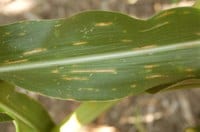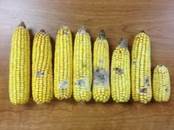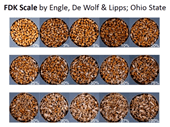Good afternoon,
I am writing this Ag and Natural Resources Update in anticipation of a few more drying days. This summer we have received the highest amount of rain in June according to our Hardin County OSU Extension Township Rainfall Reporters who have been keeping track of precipitation locally since 1993. The wettest June on record in our office was June 2009, which had an average of 8.46 inches of rain for the month. In the month of June 2015, Extension rainfall reporters recorded an average of 10.99 inches of rain in Hardin County. Last year, the average rainfall for June was 5.52 inches. Rainfall for June was 6.79 inches more for the month than for the ten year average rainfall in the month of June. For more township rainfall information, see the attached June 2015 rainfall summary.
This abundance of rain has had a great effect on the crops and gardens. Now with the excessive rain and increased humidity, we need to be on the lookout for diseases. I have attached an article about wet gardens to this email which goes into detail about what the gardener can do to try to make the best of this saturated situation. This article was written by Hancock County Extension Educator Ed Lentz. Weeds are becoming a major issue as well, so gardeners will need to stay on top of this problem too. Remember to stay well hydrated by drinking plenty of water when working outside in this hot and humid weather.
This past week there were a total of 8 Western Bean Cutworm moths caught in the four traps I have placed around the county. This is an increase over the previous week, but not yet at threshold levels. As more corn comes into tassel, we should expect to see more Western Bean Cutworm moths in flight as we are approaching the mid-season for this corn pest. Most of the highest concentration of these moths have been in the northern corners of the state in previous years, but they are starting to make their way across Ohio. See the article below for more information.
If you are interested in hops production and missed the registration deadline for the Wooster event, there is another Hops Production Field Night being held at OSU South Centers in Piketon if you are willing to travel. I have attached a copy of the flyer for this July 30 program to this newsletter. There will be a Vegetable Crops Field Night in Fremont on August 6. See the attached flyer for more information about this program which will be held at the North Central Agricultural Research Station.
Locally, Austin Heil from Homestead Precision Agriculture is hosting an ‘Unmanned Aerial Systems VIP Training Class’ at the Christian Missionary Alliance Church in Kenton on August 21st from 8:30 am -2:30 pm. See the attached flyer for more details if interested in registering for this class. Other upcoming local events include a Master Gardener meeting on Monday, July 27, starting at 7:00 pm at Harco Industries. Below I have included some agronomy articles for your review.
Mark
Foliar Diseases Already Showing up in Corn – Pierce Paul
Foliar diseases, especially Gray Leaf Spot (GLS) and Northern Corn Leaf Blight (NCLB), are already showing up in some corn fields. Although this a little bit on the early side for Ohio, it is not at all surprising, since we have had several wet, humid days over the past few weeks, with moderate to warm temperatures. Both GLS and NCLB are favored by wet conditions, particularly if temperatures are within the favorable range like they have been (70 to 90 F for GLS and 66 to 80 F for NCLB). For more information about corn foliar diseases, go to http://corn.osu.edu/newsletters/2015/2015-20/foliar-diseases-already-showing-up-in-corn.
OSU Extension to Hold NW Ohio Precision Ag Day and “Fert-Cert” August 4th – Eric Richer
Farmers and crop consultants interested in seeing the latest nutrient application equipment for corn, soybeans and wheat are encouraged to attend the Tuesday, August 4th Northwest Ohio Precision Ag Technology Day at Fulton Co Fairgrounds in Wauseon. This year’s field operation of interest is precision nutrient management. The event will qualify as a full, 3 hour “fert-cert” to comply with Ohio Senate Bill 150 regulations. The event will also offer at least 4 hours of Certified Crop Advisor credits, including Soil/Water and Nutrient Management. To read more about the Northwest Ohio Precision Ag Day, go to http://corn.osu.edu/newsletters/2015/2015-20/osu-extension-to-hold-nw-ohio-precision-ag-day-and-201cfert-cert201d-august-4th.
Western Bean Cutworm Flight Has Begun – Andy Michel
Our trapping network has started to catch western bean cutworm (WBC) adults, meaning that flight is underway. WBC emergence occurs, for the most part, during July, although it can be extended into August, so we expect our counts to increase. Females lay eggs on corn, and, after hatch, the larvae feed on the tassel, pollen or silk before entering the ear. Late season damage can be quite substantial, as shown in the figure. To read more about the flight of the Western Bean Cutworm, go to http://corn.osu.edu/newsletters/2015/2015-20/western-bean-cutworm-flight-has-begun.
Planting Scabby Wheat – Pierce Paul
Although scab was not widespread in Ohio this year, there were a few pockets with high levels of the disease in some parts of the state. In addition, persistent rainfall over the last several weeks has caused producers to be concerned about grain quality even in fields without high levels of scab. One of the main questions being asked is whether scab will affect the quality of the wheat seed this fall. Yes, scab will indeed reduce seed quality tremendously, causing germination rates and stands to plummet. However, the vomitoxin that is usually present in scabby seed is not your biggest problem in terms seed germination, damage to the embryo is your problem. You should first pull a grain sample from your lot and determine how badly damaged the kernels are. For more information, go to http://corn.osu.edu/newsletters/2015/2015-21/planting-scabby-wheat.
How much N has been lost this year? – Steve Culman, Greg LaBarge
Rain. Rain. Rain. With excessive rain, chances are good most fields across this state have lost more N than in a typical year. But how much have they lost? Everything applied? Is all of the N fertilizer gone? Although it’s difficult to estimate, it’s very unlikely that the majority of the N applied has been lost. Nitrogen losses in Ohio fields occur by two main pathways: denitrification and leaching. Both pathways occur with nitrate (NO3-), a form of nitrogen that is readily available for plant uptake, but also susceptible to environmental loss. Denitrification is more prominent in heavy, poorly drained soils while leaching occurs more in lighter, well drained soils. Most soils will experience some N loss through both pathways, but the proportion from the two pathways can vary dramatically between soils. To finish reading this article about nitrogen loss, go to http://corn.osu.edu/newsletters/2015/2015-21/how-much-n-has-been-lost-this-year.
Mark A. Badertscher
Agriculture and Natural Resources Educator
OSU Extension Hardin County
1021 W. Lima Street, Suite 103, Kenton, OH 43326
419-674-2297 Office





